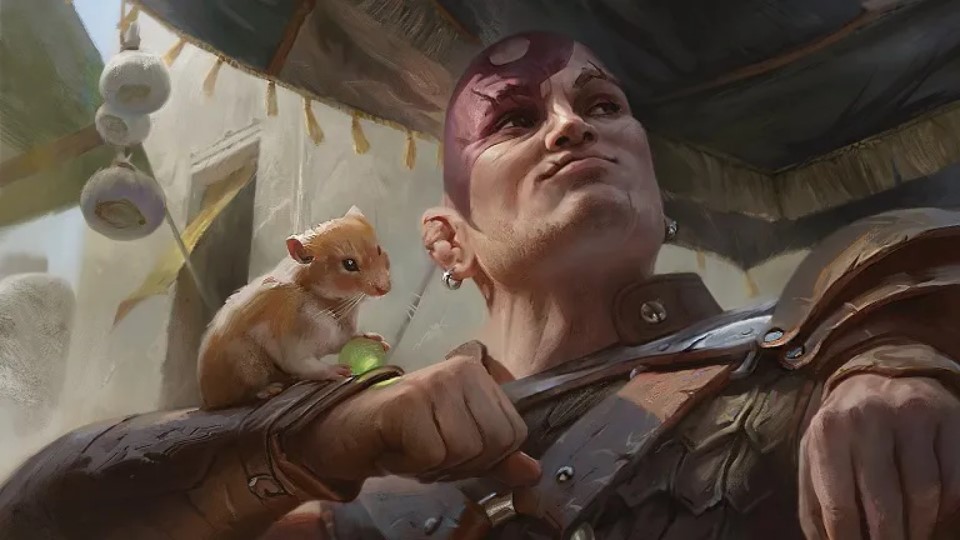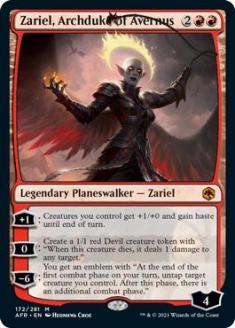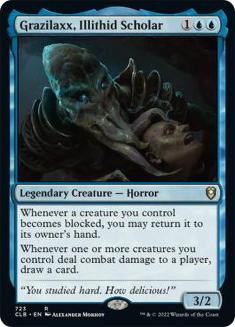Hail and well met, adventurer! You have arrived just in time! Welcome to Baldur’s Gate, one of the most famous cities in all of the Forgotten Realms! Step quickly, keep your coin purse close, and keep your wits about you. Baldur’s Gate is a dangerous place and the Flaming Fist mercenaries who keep the peace here are no less treacherous. We must make haste if we are to meet my contact at the Blushing Mermaid. While she may not be entirely on the level, she has proven . . .resourceful. Watch your step; this place can be a little rough!
I see fresh faces have joined your party since we last met! Allow me to introduce myself. Karington Hess, at your service. I am Star City Comics & Games Manager, Magic: The Gathering enthusiast, Commander player, Dungeons & Dragons fan, and Dungeon Master. I also run role-playing games professionally.
If you have read any of my previous articles, you know that I have an appetite for flavor and Adventures in the Forgotten Realms is my favorite Magic set so far. I am also an avid Magic fan and Commander player, so imagine my excitement when I learned of the return to the Forgotten Realms, this time with a Commander Legends set and a fan-favorite locale: Baldur’s Gate!
Today I wanted to give an overview of Baldur’s Gate and explain why this locale is so important and well-loved by D&D fans. Baldur’s Gate is a very dangerous location even for veteran heroes. I really enjoy dark and gritty campaigns, so I enjoy telling stories set in Baldur’s Gate. [Interestingly, I am actually running a group of clients through Baldur’s Gate: Descent into Avernus as I write this article, so the topic is fresh on my mind!]
The Real-World Lore
In our world, Baldur’s Gate began as a video game series set in the Forgotten Realms. Originally developed by BioWare in 1998 using their Infinity Engine, Baldur’s Gate would grow to be one of the most well-known and beloved video game franchises, with two sequels and multiple expansions. It would also earn multiple accolades, including the Origins Award forBest Role-Playing Computer Game of 1998,and sell more than 3.5 million units worldwide.
Its current iteration, Baldur’s Gate III, developed by Larian Studios, takes place nearly 100 years after the events of the first two games. The game is still in early access, with new content developed regularly. The storyline of Baldur’s Gate has also received a novelization and a comic titled Dungeons & Dragons: Legends of Baldur’s Gate, which takes place generations later and features Minsc as the main character. As we will see in future articles, many of the plotlines, playable characters, and NPCs from across the franchise appear in Commander Legends: Battle for Baldur’s Gate.
The Founding of Baldur’s Gate
I suppose we should begin the lore by describing how Baldur’s Gate came to be and how it received its iconic name. Centuries ago, Baldur’s Gate, originally known as the village of Gray Harbor, was home to the legendary adventurer and explorer Balduran, who returned from his exploits with untold riches, which he shared with his friends and family.
This sudden windfall allowed the small village located on the Chionthar River to grow very quickly. Enterprises launched, docks expanded, and defensive walls rose to protect the city and its newfound wealth. In honor of Balduran’s heroic gift and patronage, the citizenry began calling one of the passages Baldur’s Gate. Soon after, this name became common parlance, and the settlement itself gained the name Baldur’s Gate. The city would grow quickly as all manner of people from peasant to pirate were looking to find opportunity within the rapidly expanding city. In the centuries to follow, Baldur’s Gate would grow to become a central hub for both river and ocean trade along the Sword Coast.
The Patriars
As the city’s population grew, the wealthy families, eventually known as patriars, enacted taxes on trade and travel. This unpopular decision led to civil unrest and violence between the patriars and the common citizens of what would become known as the Lower City. Patriar homes were sacked, family members kidnapped, and riches stolen. Gold and blood flowed in equal measure as the patriars turned to hired mercenaries for protection.
The bloodshed ended when the Council of Four (made up of four elected dukes) put the matter to rest; they have ruled over Baldur’s Gate ever since. Another faction rising from the ashes of the conflict was the Flaming Fist Mercenary Company, a group of independent mercenary companies united by the adventurer Eltan under a common banner. The Flaming Fist operate as a blunt instrument to quash disorder and punish those who would disrupt the newly found peace of Baldur’s Gate.
The Machinations of Bhaal
Even with the newly found peace established by the patriars, the Flaming Fist, and the Council of Four, blackmail, theft, assassination, and other dark deeds still occur in dark alleys and behind closed doors. But these conspiracies pale in comparison to the machinations of Bhaal, god of murder. Foreseeing his own demise during the Time of Troubles, he conceived a plan to resurrect himself by way of his own progeny.
As the mortal children of Bhaal, known as Bhaalspawn, hunted and slew one another, they would absorb more and more of their father’s divine essence. One such Bhaalspawn, known as Sarevok, sought to instigate a war between Amn and Baldur’s Gate in a bid to supplant Bhaal and become the new Lord of Murder. Fortunately for the realms, a group of adventurers (including a fellow Bhaalspawn) thwarted Sarevok’s plans and returned Baldur’s Gate to a state of relative peace. However, the fates of Baldur’s Gate, Bhaal, and his worshipers remain intertwined, and serve as a constant threat to the safety of Baldur’s Gate.
Modern-Day Baldur’s Gate
To this day, Baldur’s Gate remains a dangerous locale. Even the most battle-hardened veteran adventurers mind their step as they tread through the City of Blood, as one nickname goes. The city has grown beyond the Upper City and Lower City. Those barred from entering have set up ramshackle hovels just outside the gates, forming the Outer City, a massive web of small dwellings and hastily constructed shops. These citizens are among the most desperate, hoping to snare enough coin to survive.
As a central trade hub, Baldur’s Gate constantly receives goods from its surrounding trade partners, including Neverwinter to the north, Calmishan to the south, and Chult across the sea to the west. The Flaming Fist continues to maintain a semblance of order, but many members take a greater interest in lining their own pockets and corruption is rampant.
The patriars, separated from the denizens of Baldur’s Gate, are looked after by The Watch. The Watch are well-paid and well-organized mercenaries, often viewed as glorified bodyguards, and are interested only in protecting the Upper City and the patriar ruling class. With no real forces of order looking out for the average citizen, those who do not have the pull or funds to guarantee security have banded into “crews” to protect themselves when the Flaming Fist can’t–or won’t–intervene. In order to prevent accidentally revealing their alliances, it is customary to use the nearest gate as a demonym, such as “Cliffgater” or “Gondgater.”
Threats Within and Beyond Baldur’s Gate
A powerful shadowy criminal element operates within the city, known only as the Guild; nearly anything from arms and armor to illicit poisons and substances can be found if you know where to look. Kingpins oversee each region throughout Baldur’s Gate. These kingpins oversee all organized crime within their district, from petty larceny to assassinations. Each kingpin answers to their enigmatic guild leader, which is currently (though unknown by many) Nine-Fingers Keene, an unassuming yet ruthless middle-aged woman. Thoughtful, pragmatic, and even respected, Nine-Fingers Keene ensures that the enterprises of the guild remain profitable, and she metes out vengeance as necessary.
Bhaal is still a threat. Now a demigod, he has aligned himself with two other demigods (Bane, the God of Tyranny, and Myrkul, the Lord of Bones) to form the Dead Three. The Dead Three have lost much of their divine power since the Time of Troubles, when gods were made flesh and many perished. Rumor has them taking flesh once more and even walking the streets of Baldur’s Gate. Cultists of Bane seek to elevate the strong while dominating and preying upon the weak. Cultists of Myrkul seek power over the dead and knowledge lost to death. While membership in the Cult of the Dead Three is small, they are widely known and rightly feared.
Nine Hells and Mind Flayers
Recently, the Holy City of Elturel was ripped into the Nine Hells, and it was rumored that the same fate was being planned for Baldur’s Gate. Fiendish cults have begun exerting their influence across the Sword Coast, seeking fresh souls and soldiers to fight in the conflict known as the Blood War–an eternal war raging between the demonic forces of the abyss and the legions of devils who fight to keep them at bay. Mortals often fall to temptation, signing contracts for their very souls in service to powerful devils for power, wealth, or other reasons. Rumor has it that the corruption of the fiendish cults has made its way to the highest offices within Baldur’s Gate and is looking to strike. Supposedly, Zariel, Archduke of Avernus has her eye on Baldur’s Gate, and she is not often denied.
Most recently, in Baldur’s Gate III, the opening sequence of the game begins with a new threat to the city: Mind Flayers, or Illithids as they are often called. These extra-dimensional beings are transported in living ships known as Nautiloids, which they use to capture prey. We have seen Mind Flayers before in Magic: The Gathering, represented by the cards Mind Flayer; Grazilaxx, Illithid Scholar; and Nihiloor. These terrifying aberrations can control minds and feast upon the gray matter of living victims. Mind Flayers also reproduce in a horrifying way, by implanting their young into the skull of a living host, where it consumes the brain and mutates the body through a process called ceremorphosis. Yuck. Mind Flayers most often live in colonies and operate as a hive mind under the control of an Elder Brain made up of brains from the dead Mind Flayers.
Enter Baldur’s Gate
As you can see, Baldur’s Gate contains a rich history and offers a fantastic location for Dungeon Masters to weave their stories. There is a lot going on here and I am excited to see how Commander Legends: Battle for Baldur’s Gate interprets the setting and adds to the narrative.
As I mentioned earlier in the article, I really like that Baldur’s Gate is a dark and gritty setting. It offers characters a morally gray backdrop for them to make a difference and be heroes. I am excited to explore this fan-favorite setting, especially as the history extends nearly as far back as the inception of Magic: The Gathering itself.
Keep an eye out for more articles coming soon!
I hope you enjoyed this article. If you are a Dungeons & Dragons fan like me and want to read more of my musings about dungeons, dragons, and Game Master advice, check out my blog.





